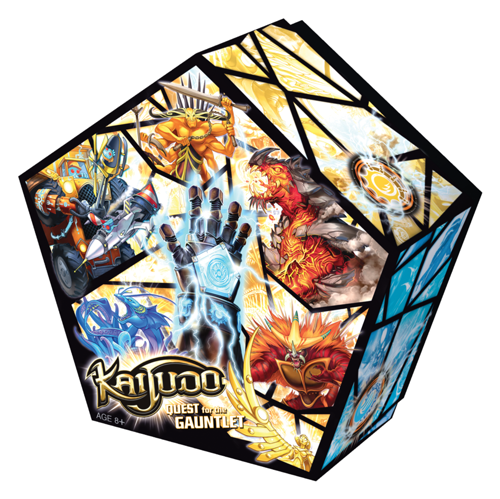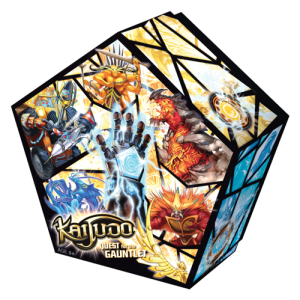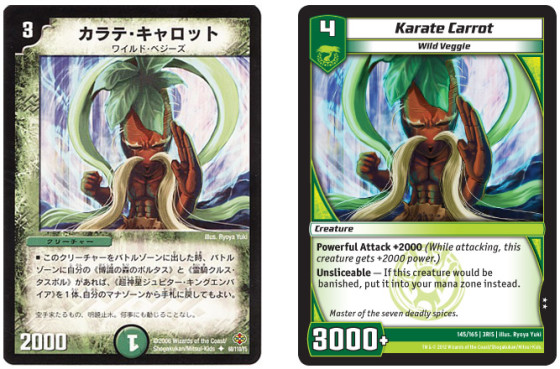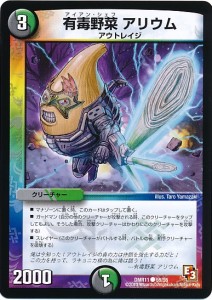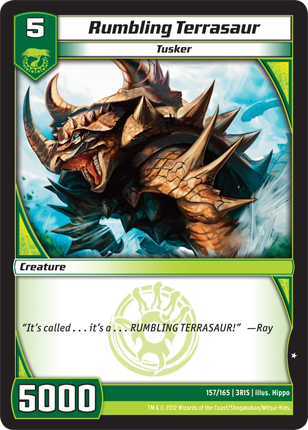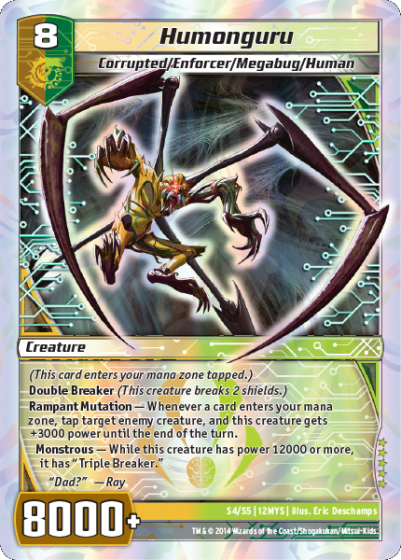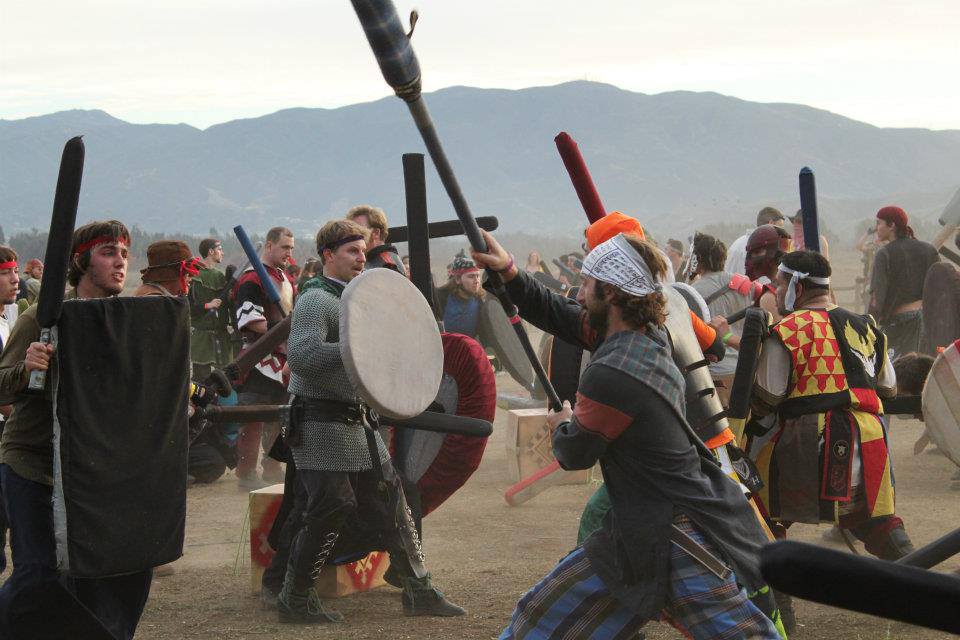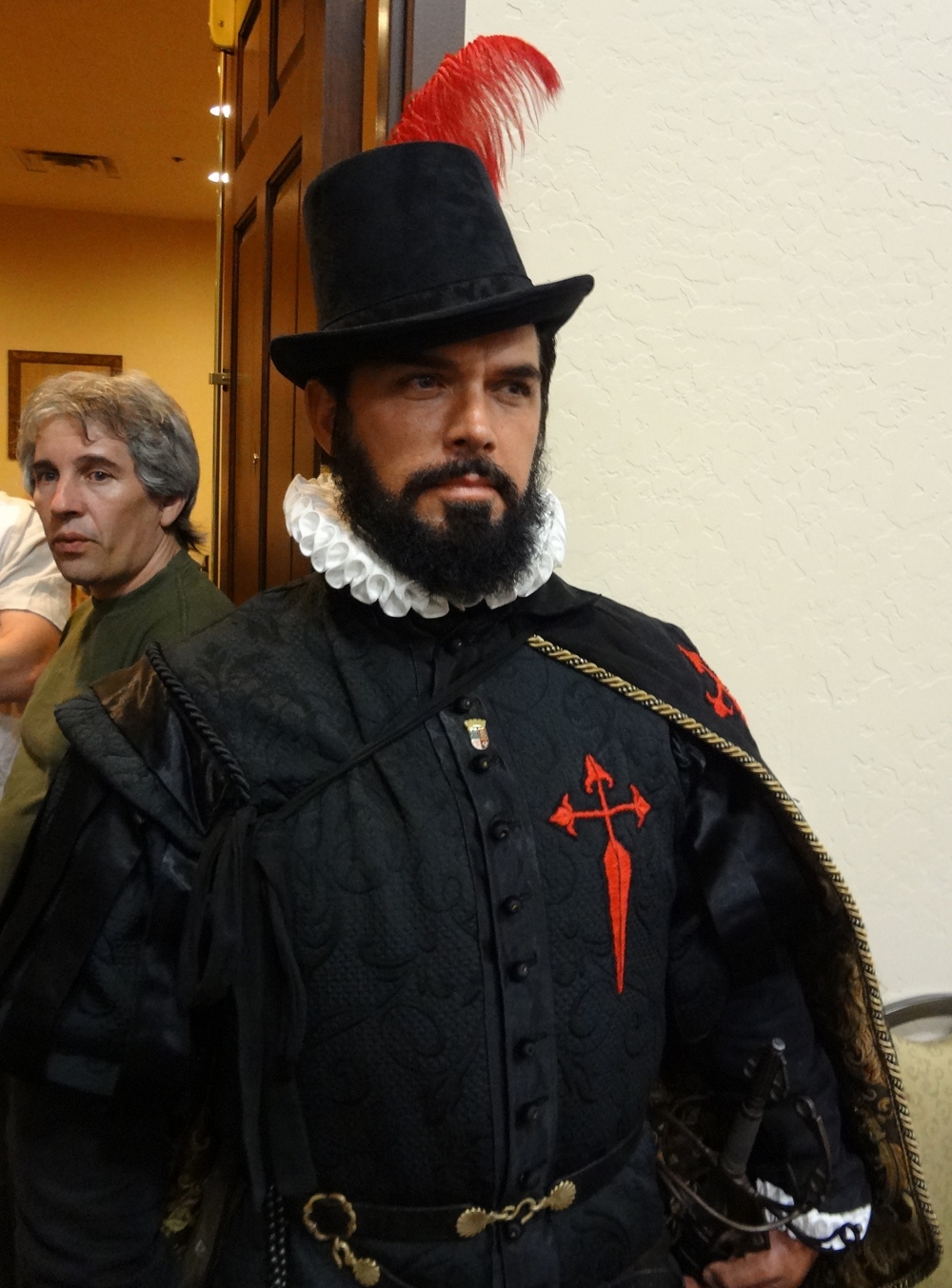Kicking Off Kaijudo’s Quest for the Gauntlet with Drew Nolosco
Back at the 2014 GAMA Trade Show I had a chance to preview the all-new Kaijudo draft experience at the Wednesday game night on March 18. I also had the opportunity to interview Kaijudo Lead Designer Drew Nolosco about the then-upcoming Quest for the Gauntlet expansion, which recently launched on May 30. On May 31 I went to Little Shop of Magic here in Las Vegas and battled several other Duelists in a sealed event using the well-designed Quest for the Gauntlet Collector’s Box to construct our decks. While we did not draft, we sunk our teeth into the new cards and had a blast. I ended up winning the tournament (and six more Quest for the Gauntlet booster packs as well as four foil promo cards). Here’s what Drew Nolasco had to say about designing this awesome play experience.
Lead Designer vs. Lead Developer at WotC
CG: So how did you get started with Kaijudo at Wizards of the Coast?
DN: So I was hired as Lead Developer for Duel Masters, because Kaijudo had not been yet announced. So when I arrived at WotC, having accepted the offer, my boss said to me, “There’s something we need to tell you. We have this new brand called Kaijudo; we’re launching the Duel Masters rules engine in the United States under this brand named Kaijudo. There’s this TV show that we’re working with Hasbro Studios to create.” And I moved into the Lead Developer for Kaijudo. So at Wizards of the Coast, we have a two-step design process. Designers drive innovation and new mechanics. Their job is to unfetter innovation. Developers take the second half of the design process and they drive balanced, fun gameplay. So that was my job. I also ran the Story and Worldbuilding team, which I still do. About a year ago, I transitioned over from Lead Developer to Lead Designer and so now I’m driving innovation for Kaijudo.
CG: So do the developers and designers ever clash?
DN: We work collaboratively, but there is a very healthy tension in this design process. By separating out balance from innovation, it allows the designers to go off into these brave, new worlds and create brave, new worlds, and really come up with gameplay mechanics that are exciting that they don’t have to worry about the minutiae of balance. They have to innovate. And innovation is best when it is freed from concerns. We look, as designers, at player experience. What’s it going to be like to sit down and play our game? What is the surprise and delight that you’re going to get when you buy a new pack of Kaijudo or experience a new set? Or discover a connection between two different cards? And then the developers take – this is the back half of design – and they say, what’s going to make this fun consistently? What’s going to make this game have legs? What’s going to make this game be the kind of game you want to play 8, or 9, or 25, or a hundred times? And the successful marriage of these two parts of the design process is really what allows WotC’s games to have that long player experience. It’s why you come back to play Magic year after year after year. We’re hitting 20 years of Magic. It’s that two-step process that really gives our games the depth and the freshness at the same time.
Individual Card Design: Karate Carrots and Iron Chefs
CG: Now how does an individual card like Karate Carrot fit into process? Is that a designer or a developer?
DN: It’s some of both. Kaijudo utilizes some of the art assets from Duel Masters. Duel Masters is a longstanding WotC game that is currently the number one TCG in Japan. And it’s been a Japanese-only product. They have some amazing and really off-the-wall inspiring art, like Karate Carrot. It’s a carrot! It’s a karate guy! When a designer looks at that card, we have top-down design where we take a thematic element. This is a carrot and he knows martial arts and we design a card around that. It’s really exciting, because you have this off-the-wall wackiness and you have to translate that into the framework of a game system, Kaijudo. He has the ability Unsliceable; he doesn’t die, he goes to the Mana Zone, so we can take elements from this and create gameplay around it. And we get this evocative card. Karate Carrot is very clearly one of the most [laughs] popular characters in Kaijudo.
CG: Oh, it is?
DN: Yeah, yeah. It’s because he’s so unusual. A funny Kaijudo anecdote: So we, WotC, worked with Hasbro Studios collaboratively to create the brand. The Hasbro Studios writing team was responsible for the story and plot line of the TV show and we were responsible for the story and plot line of the trading card game and we successfully merged them. But we would have a lot of back and forth, so for example, they came to us and said “We think we might want a robotic chef character.” And the WotC team was like, “We have that art ready for you!” And when we went through the Duel Masters library, sure enough, there was Iron Chef. And it was this crazy piece of art. He ended up not getting used in the show…
CG: Somewhere in R&D-, you would be considered R&D?
DN: I am in R&D.
CG: Who’s the real guru in R&D that knows all of the Duel Masters stuff, where you’re just like, “Do we have that?” and he’s like “Yeah, we have it.” I assume it’s a guy.
DN: So there is a Duel Masters team. Duel Masters is still in production. They hit their… 5 billionth card produced. So in my group, our boss is Charlie Catino, he’s the Director of New Business and Japanese Games. There’s Shaba [Masami Ibamoto]. He’s the Lead Designer for Duel Masters and Mons Johnson is the Lead Developer. He’s also the Lead Developer for Kaijudo. He does both and they know the ins and outs of Duel Masters like nobody’s business.
CG: So they feed stuff to you guys.
DN: They feed some stuff to us. All of that art is in a database, so we go pore through that database for amazing art. The rules engine for Kaijudo and the rules engine for Duel Masters are siblings; there are some differences. But they are close enough that we can take inspiration from Duel Masters as well as new innovation to create new Kaijudo mechanics.
Quest for the Gauntlet and the Draft Experience
 CG: So if we fast forward to the Quest for the Gauntlet, coming out on May 30, what different things are we going to see that might surprise us?
CG: So if we fast forward to the Quest for the Gauntlet, coming out on May 30, what different things are we going to see that might surprise us?
DN: There’s some groundbreaking stuff that we’ve done. Many of the action TCG games that are like Kaijudo have 9 or so card booster packs and one of the things that’s new with Quest for the Gauntlet is that we’ve increased the number of cards in a pack from 9 to 14. And the MSRP is still the same, it’s still $3.99 per pack. The advantage that we get off that – and the advantage the players get off that – is that they can draft using three packs. That is a very affordable draft experience. And we’ve also added in draft as a design philosophy for Kaijudo. So we’ve taken all of WotC’s cumulative knowledge about how to make great draft environments and applied them in a uniquely Kaijudo way, so starting with Quest for the Gauntlet, you’ll be able to have this amazing draft experience out of an affordable three packs.
CG: So it’s basically a $12 experience?
DN: Yeah.
CG: Which is very affordable.
DN: It’s very affordable! Previously people were trying to draft with five or six 9-card packs, because you need a certain amount of cards to make a draft successful. Those are very expensive. And we went to the retailers, which is the customers, and they said “We’d really like Kaijudo for drafting.” They were hampered by this problem of it really is kind of expensive. So growing Kaijudo means responding to the needs of the players, responding to the needs of the retail community and we met that need.
Quest for the Gauntlet and Player Excitement
CG: Are we going to see any new abilities-, what’s your term as a designer for abilities that applied across several different creatures?
DN: Just mechanics, abilities. That’s a fine term for it. We haven’t started previews for Quest for the Gauntlet cards.
CG: Right. So what we were playing in there [the Kaijudo draft preview with retailers], I recognized most of those cards.
DN: Right. That was not Quest for the Gauntlet. The draft experience that retailers had at the GTS show is that we took the design philosophy of draft and we created a special set of cards using already-printed cards that has the number of Shield Blasts, and this mechanic, and that mechanic representative of what we’ll see in Quest for the Gauntlet, but using cards that have already been seen.
CG: I know. I was really hoping that I would be able to film my experience, here’s this card, here’s this new card, because when I interviewed Kieren Chase, I know from comments that people actually were watching it in high definition and they were pausing because new cards were being displayed on screen that these fans that run some sort of wiki-
DN: The Kaijudo wiki.
CG: Yeah, they were hastily transcribing them, so eager to update their list of what the cards were.
DN: Isn’t that excitement awesome?! The steps that the fan community goes through to suss out this information is very, very inspiring. We’ll be previewing Gauntlet cards soon. There will at least two new mechanics. One of them is something that players have been anticipating, hoping that they would see, so we expect a lot of exciting satisfaction for the players.
CG: How is it going to be supported with other products?
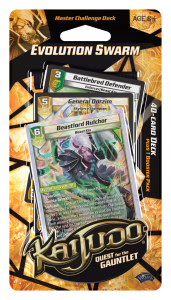 DN: There will be a deck product that comes out with Quest with the Gauntlet. It is a rather competitive deck in of itself, which means that you can take this deck to your Duel Day which is our weekly Kaijudo organized play event at retail stores and without modifying it, you’ll do fine. It’s a good deck. Our philosophy for decks is more towards great play experiences right out of the package and not so much as an intro experience. Our intro experiences are free product, free sample decks, and the Kaijudo Duel Day deck. Sample decks are aimed at people who are new to TCGs, perhaps younger players or people who are learning Kaijudo as their first TCG. The Kaijudo Duel Day deck is aimed at players who are experienced TCGers who are just coming to Kaijudo as a new TCG they’re playing, so it speaks to them on their level and it doesn’t do things like tell you, “Here’s how TCG works.” It says, “You are already a player, you are already in the game. Here are the three or four things you need to know that makes Kaijudo unique and you can take this deck and start playing with it right away.”
DN: There will be a deck product that comes out with Quest with the Gauntlet. It is a rather competitive deck in of itself, which means that you can take this deck to your Duel Day which is our weekly Kaijudo organized play event at retail stores and without modifying it, you’ll do fine. It’s a good deck. Our philosophy for decks is more towards great play experiences right out of the package and not so much as an intro experience. Our intro experiences are free product, free sample decks, and the Kaijudo Duel Day deck. Sample decks are aimed at people who are new to TCGs, perhaps younger players or people who are learning Kaijudo as their first TCG. The Kaijudo Duel Day deck is aimed at players who are experienced TCGers who are just coming to Kaijudo as a new TCG they’re playing, so it speaks to them on their level and it doesn’t do things like tell you, “Here’s how TCG works.” It says, “You are already a player, you are already in the game. Here are the three or four things you need to know that makes Kaijudo unique and you can take this deck and start playing with it right away.”
The Initial Tatsurion vs. Razorkinder Decks
CG: Now going way back to the launch of the whole Kaijudo brand, you had the Tatsurion deck versus Razorkinder, what was the ultimate feedback on that? In my own playing the Razorkinder deck won so infrequently against Tatsurion. Do you have a number on it?
DN: It is extremely difficult to balance decks. However those decks were actually reasonably balanced. Do you perhaps prefer a more aggressive deck style?
CG: I don’t know? But it really came down to 80-20 [in percentage of the Nature-Fire Tatsurion deck’s wins]. It was so hard for the Razorkinder to beat the Tatsurion deck against many different opponents, no matter who they were. I would always be like “Oh, you’re new? I’ll let you play Tatsurion, I’ll play Razorkinder.” I did that in the hopes that they would enjoy the game and enjoy their victory, because that’s what it turned out to be a lot of the time, but uh, this isn’t the first time you’ve heard this or not?
DN: It’s not the first time I’ve heard this. I’ve heard of differing results from either deck. I think, in retrospect, the Tatsurion deck has an easier time getting a board presence established and can come in slightly faster than the Razorkinder deck. The Razorkinder deck has good draws that allow it to regain control, but aggression is good.
The Roll of Vanilla Cards and Games that Teach Themselves
CG: Do you call a generic card a vanilla?
DN: Yes, yes we do.
CG: Who made the decision, let’s have vanilla cards! Or as to what percentage of vanilla cards should we have versus ones with actual abilities? I think a Rumbling Terrasaur is just a Rumbling Terrasaur, right?
DN: That is correct. It’s a Level 5 for 5K Nature creature. So, I’m part of that decision-making process. Especially when a game is new to the market, we need to segue players from one packet of information to the next to the next. If you provide too much information at once, it’s very easy to overwhelm people and then they have a disappointing experience. You and I as experienced TCG players can look at a vanilla card and find it wanting because it doesn’t have have that level of oomph or newness and freshness, but for someone who is coming into a game, vanillas serve a really important purpose. They show you the philosophy of each civilization in terms of creatures. So, for example, Nature gets a 5 for 5K, it gets a 3 for 3, a 4 for 4. It gets creatures that give you bang for the buck, whereas, say Darkness, does not have quite as good creatures in terms of Power to Level ratio. So you get a 5 for 3k for example. And that teaches you something. And then when you start layering in the next packet of information which is Keyword Abilities. So, you’ll say, “Well, ok, my Darkness creature is 5 for 3k but it gets Slayer, which is a really cool ability that basically lets me Banish anything.” That progression of information, which starts from the smallest amount of information we can present in one card, and then layers in and in, allows players to ramp up to the point where they can process a more complex card. So vanillas are really important. As Kaijudo has matured, the proportion of vanillas to non-vanilla cards drops a little bit, because we have a more experienced player base who don’t need as much hand-holding, but it’s extremely important for your first large set to have enough vanillas to ease people into more complex concepts.
CG: What taught you that? Is that coming from you or did some Magic designers say “Hey-”
DN: So, there is institutional knowledge, which is one of the amazing things about WotC. We are very good in R&D about sharing knowledge through generations of designers. We’ve been doing this for a … long time. That knowledge becomes institutionalized. We, as designers and R&D members, add to that institutional knowledge. So some of it, yes, comes from the experiences of those who’ve come before us. Some of it comes from personal experience; I’ve been doing this thirteen years in one capacity at a company or another. Learning how to teach without a rulebook. Teaching people by just handing them cards, seeing what they learn, how they progress one from competency level to the next higher competency level has been an important learning experience in my personal development as a game designer and I’m very happy with the way that I’ve been able to express that in Kaijudo.
CG: In video games, there’s a lot of the same principles. A well-designed video game, you learn the game-
DN: As you’re playing! Yes, exactly.
CG: So that was intentional with Kaijudo?
DN: Yes. Very specifically engineered into the way that we did the first several sets.
Drew Nolosco’s Excitement About Kaijudo Draft
CG: Now you’re here at GAMA Trade Show; is this your first time here?
DN: Uh, my first time as a Wizards employee, yes.
CG: Who were you here with before or what were you doing here before?
DN: Prior to working at Wizards of the Coast, I was with a number of other companies, so I’ve been here a number of different times in my professional career. [Drew did not elaborate, but among these were WizKids and To Be Continued (Chaotic TCG)]
CG: What are you most excited about being here? Is it the 14-card draft format?
DN: It’s specifically draft.
CG: Professionally, you’re excited to see it, draft, unleashed?
DN: So, taking a game and realigning it for draft as a native experience, built into the game has been an extremely challenging and kind of monumental professional experience. It’s not often that you’re able to take something and then add in such a complex layer to it and have it come out and still be recognizably that original core thing, but with this new level of texture in it, so I’m extraordinarily proud of what all the people at Kaijudo R&D have been able to do, very particularly Mons Johnson, Lead Developer, has…. we’ve really done something beautiful.
CG: Not to put that down. That’s a great quote that you’ve done something beautiful. Are you saying that if home users somehow had come up with the number 14 (for the number of cards) for draft and they somehow came up with their own random packs to simulate a draft, you’re saying that there’s been enough thought in [your] process to-
DN: It’s not just 14 cards. 14 cards allows players to get the quantity of cards you need to draft at an affordable price point, but we’ve actually taken Kaijudo and layered in draft play as an integrated part of the design for Quest for the Gauntlet. We’ve layered in draft archetypes. So, how do civilization combinations approach winning the game in a draft environment. Each combination has a different tweak on what their theme is in Quest for the Gauntlet.
CG: So it might be very subtle?
DN: Sometimes it’s subtle and sometimes it’s going to hit you over the head. And the advantage of doing that is that you get replayability in draft. This is important for retailers because players will want to draft over and over again as they explore the depth of Quest for the Gauntlet in a draft environment. It’s good for players because there’s a lot of meat packed into this and it’s good for constructed players because there are a lot of newly interesting, exciting cards for them to add to current decks and add some new decks. It is a very dense – dense sounds like a pejorative – it’s a lot of greatness packed into one 170-card set. So it’s not just increasing the number of cards. We’ve done significant heavy lifting in adding in new design philosophy into Kaijudo.
Quest for the Gauntlet’s Story Arc and a Little Magic
CG: Now you oversee the story as well, so there’s a story element to this 170-card set?
DN: That’s correct.
CG: This is going to be horrible to any Magic: TG fan, but I’m a Fallen Empires-era Magic player so that would be the strongest example I know, but it’s considered the worst Magic set, I think, so I don’t want to-
DN: Hey! So, think about the cards that have come out of Fallen Empires that are tournament staples.
CG: I guess a Tourach sort of card…
DN: There’s Hymn to Tourach, there’s a number of cards that came out of that set. That set was more successful than you think. However, I understand where you’re coming from, having been a player at that time.
CG: Because I can name most of those creatures, the thallids, the Icatians, and so on. Will this have that same narrative feel? Maybe you can look at all the flavor text and figure out something about the Veil?
DN: The world that you’re in. I believe very strongly that you can’t tell narrative with a trading card game in the product itself, because players experience it in a completely random order. A narrative is a series of events that lead from establishing characters to a setting to a crisis to resolution. What you can do with trading card games is you can provide worlds that stories are told in and see parts of them just like any journey that you take real lands. You see parts of that land in the particular route order that you go. Travel US Route 1 from beginning to end you’ve seen part of the United States in an order that is very unique, but when you open Quest for the Gauntlet and any other upcoming Kaijudo set you will see the world of Kaijudo in order-, kind of dictated by the packs that you open, but you’ll be able to explore that world and get an idea of what’s going on.
However, on top of that, there is layered a very particular story arc. So the set of game cards provides a setting and there is a story that-, actually an extremely detailed story layered out on top of that that various other outlets will be telling.
Duel Masters as Cards?
CG: Now they’re called Duel Masters in the show?
DN: They are Duel Masters.
CG: Right, ok. I’m not familiar enough with all the cards, but will we ever see them, the Duel Masters, as cards, in a Planeswalker kind of way?
DN: You are the Duelist in Kaijudo.
CG: So we won’t see a Gabe.
DN: No, no. But you’ll see the creatures Gabe summons and you’ll have an opportunity to summon them and sometimes you’ll recreate the experiences that you saw on TV. But more often you’ll be creating new experiences and new stories as you play through the games using those creatures. We’ve made a very conscious decision that the human characters in the world of Kaijudo don’t appear on game cards and fans reading this will immediately point out the one exception, who is the one human character who became mutated… But, in general, no, you are the Duelist, you are a Duel Master as a player, summoning creatures, and creating your own stories with them.
CG: Ok. What in particular is most exciting to you about Quest for the Gauntlet, an ability, a card, anything? Even if it’s just a name.
DN: Gargle fans will be very happy in Quest for the Gauntlet. That’s about all I can say right now. [On March 18, 2014]
All images copyright Wizards of the Coast.
